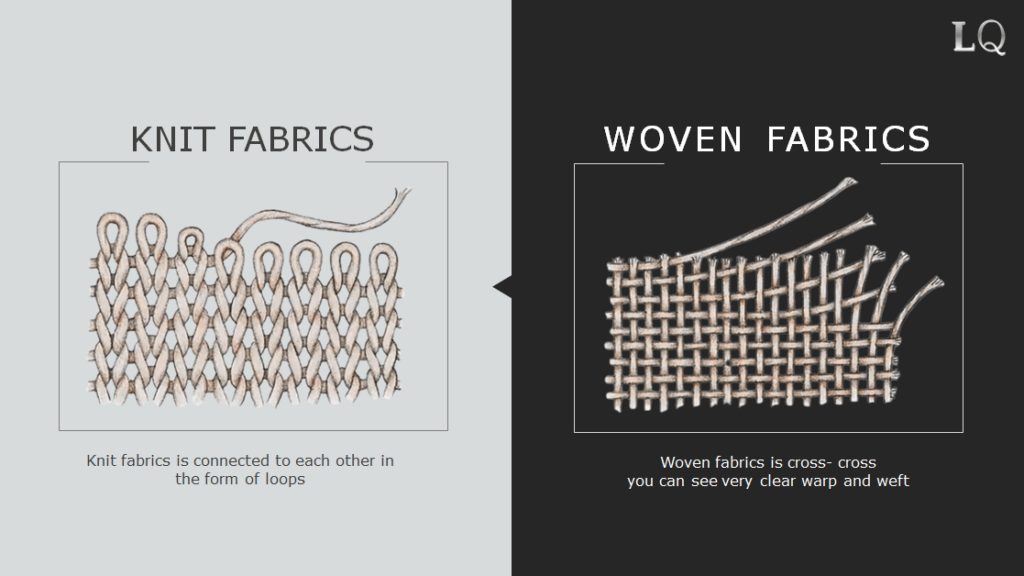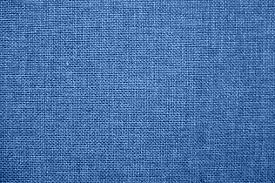Knitted and woven fabrics are the two common and wearable fabrics that are prevalent in the clothing industry today. These two are named after the methods used in making them. Knitted fabrics are interloping yarns while woven fabrics are interlaced using two sets of yarns.
In this article, we’ll expound on the differences between knitted and woven fabrics, giving you 14 uniqueness of both materials. Follow through as we dive right in!

Image Source: LinkedIn
What is a Knitted Fabric?

Image Source: Unsplash
Knitted fabric is a textile made by interlooping yarns to create a more flexible and stretchy material using a long needle or machine. Knitted fabrics are of two categories: warp knitting and weft knitting. It is made in a variety of ways: by hand, using a circular knitting method, or using a knitting machine.
Types/Examples of Knitted Fabrics
Some types/examples of knitted fabrics are;
- Jersey knit
- Sweater knit
- Rib knit
- Double knit
- French terry knit
- Fleece knit
- Purl knit
Manufacturers use knitted fabrics to design different wear such as; t-shirt, sweaters, socks, leggings, cardigans, sport/athletic wear, etc. because they are lighter and more breathable.
What is a Woven Fabric?

Image Source: Unsplash.com
Woven fabric is a textile made by interlacing/weaving two sets of yarns together at right angles to each other to create a rigid and robust structure of woven garment. Generally, manufacturers use looms to create woven fabrics, making them more stable and less stretchy compared to knitted fabrics.
One outstanding benefit of woven fabrics is that they can easily fit into your specifics. woven fabrics are cut and sewn into various shapes and sizes without destroying their structure.
Types/Examples of Woven Fabrics
Common types of woven garments include;
- Denim
- Flannel
- Chiffon
- Corduroy
- Muslin
- Cheesecloth
- Buckram
Woven garments are primarily used to make shirts, home textiles, skirts, pants, and several other dresses because of their structure.
14 Differences Between Knitted and Woven Fabrics
| S/N | Classification | Knitted Fabrics | Woven Fabrics |
| 1. | Description | Knitted fabrics are made by interlooping yarns to create a series of connected yarns, using a set of needles or machine. The yarns create a flexible and stretchy garment that is comfortable to wear.
|
Woven fabrics are made by interlacing/weaving two sets of yarns together, either manually or using a machine. The yarns are tightly woven, to create a more rigid and structured garment. |
| 2. | Durability | Knitted fabrics are less durable compared to woven fabrics, and may begin to pill or stretch out due to wear and tear. | The tightly woven yarns of woven fabric makes it durable, more resistant to wear and tear, and long-lasting. |
| 3. | Stretchability | The series of loops that form knitted fabrics, make them incredibly stretchy and flexible in both its width and length. | Woven fabrics are more rigid and less stretchy because their yarns are tightly woven into criss-cross patterns. |
| 4. | Texture | Knitted fabrics have a consistently smooth texture. Most are soft to touch, but feel bumpy or ridged because of ribbing. However, its texture can also depend on the yarn and type of knit used. | Woven fabrics come in different textures; coarse, smooth, silky, rough, etc. |
| 5. | Wrinkle-resistant | Knitted fabrics can withstand wrinkles because of their elasticity, and will not shrink when crumbled. | Due to its structure, woven fabrics are susceptible to creases and wrinkles. |
| 6. | Maintenance | Knitted fabrics require less hand-washing and are good with machine-washing. The material requires no ironing because it’s wrinkle-resistant. | Woven fabrics are less suitable with machine-washing because of its susceptibility to wrinkles and will continuously require ironing to smoothen and pristine out. |
| 7. | Weighty | The loosen and more open structure of knitted fabrics make them thinner and lighter. | Woven fabrics are thicker and heavier due to its tightly interwoven yarns. |
| 8. | Sewing | The stretchy nature of knitted fabrics makes it harder to sew (either hand or machine sewing) because stitching straight lines can cause gathers or puckers. | Woven fabrics are less stretchy, and are easy to sew without pulling gathers or puckers. |
| 9. | Manufacturing | The manufacturing process is more flexible and can produce various fabric types and designs. | The manufacturing process of woven fabrics is highly structured and accurate with little or no space for variation. |
| 10. | Expensive | The less complex manufacturing process of knitted fabrics makes it less costly. | Due to its time-consuming production process, woven fabrics are more expensive to buy even after being pre-made into clothing. |
| 11. | Shape retention | Knitted fabrics are loose in structure, elastic, and will retain their original shape when stretched. | Woven fabrics are less elastic because they are not made from elastic fiber. Therefore, they will not retain their shape when stretched. |
| 12. | Insulating | The loose and open structure of knitted fabrics make them less insulating and best for the hot season. | Woven fabrics have denser structure that makes them more insulating and best worn during the cold season. |
| 13. | Comfortability | Knitted fabrics are comfortable and appealing to wear because of their flexibility and stretchability. | The rigid structure and lack of stretchability of woven fabrics make them less comfortable to wear. |
| 14. | Versatility and Design Patterns | Knitted fabrics are more common for athletic and casual wear. Furthermore, they give room for intricate patterns and designs. | Woven garments find application in various instances, from formalwear to upholstery. The design displays an over-under pattern of weft and warp yarns. |
Conclusion
The unique differences between knitted and woven fabrics makes them suitable for different purposes and seasons. Basically, knitted fabrics are best for elastic and comfortable apparels for easy movement, but woven fabrics are best for structured apparels that need durability and complex designs.
If you are looking for an extensive collection of fabrics which include options like rib, single jersey, fleece, etc., FabKnitter offers the best choice. Our product catalog has more to offer. Check them out!
